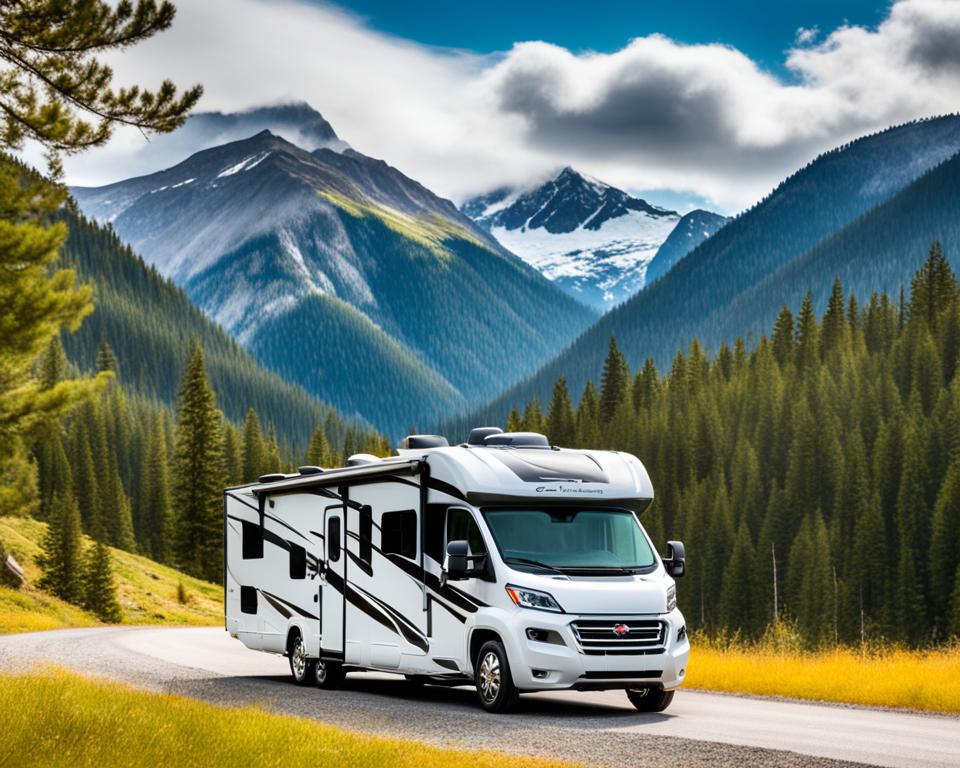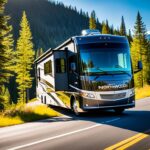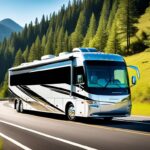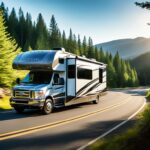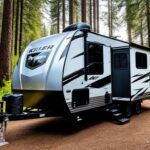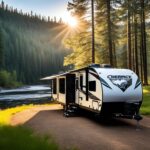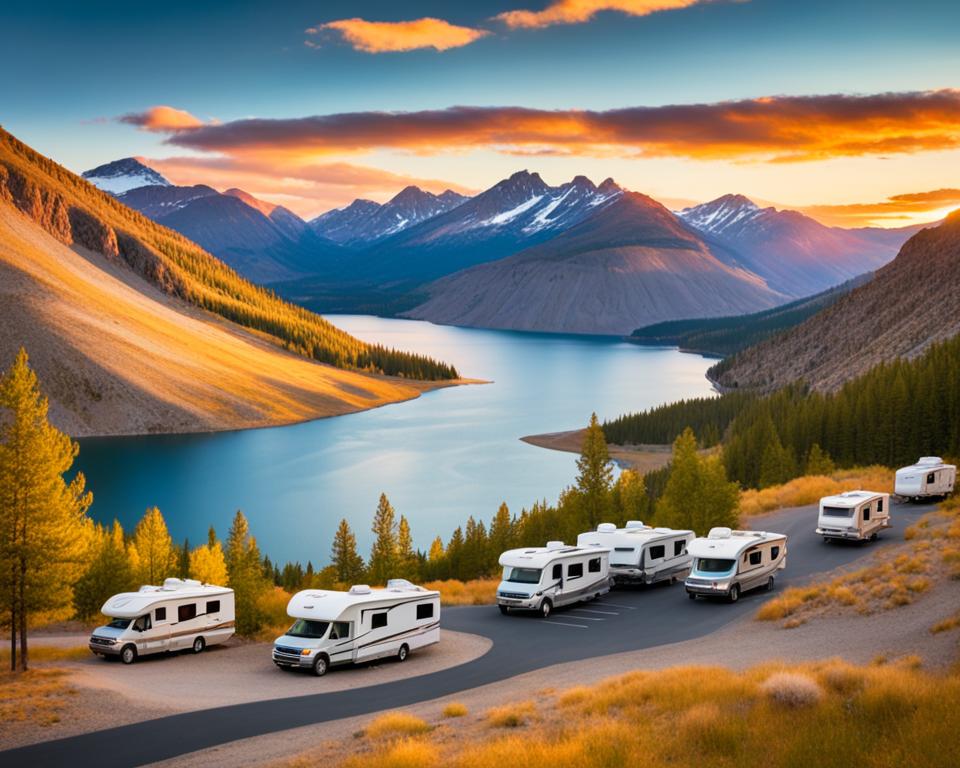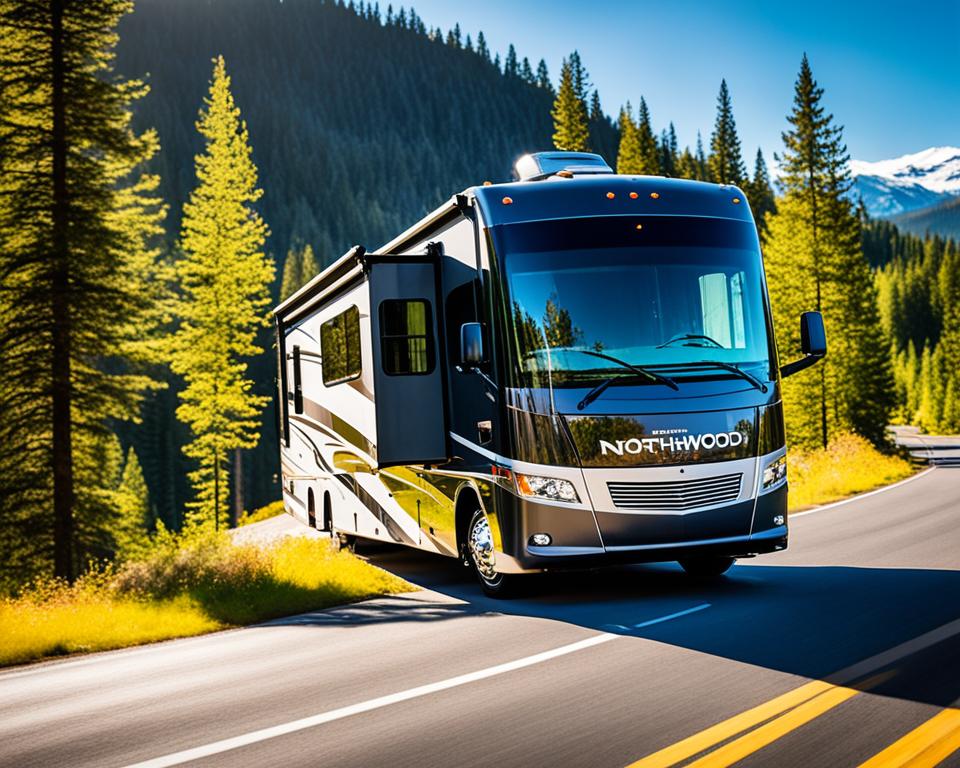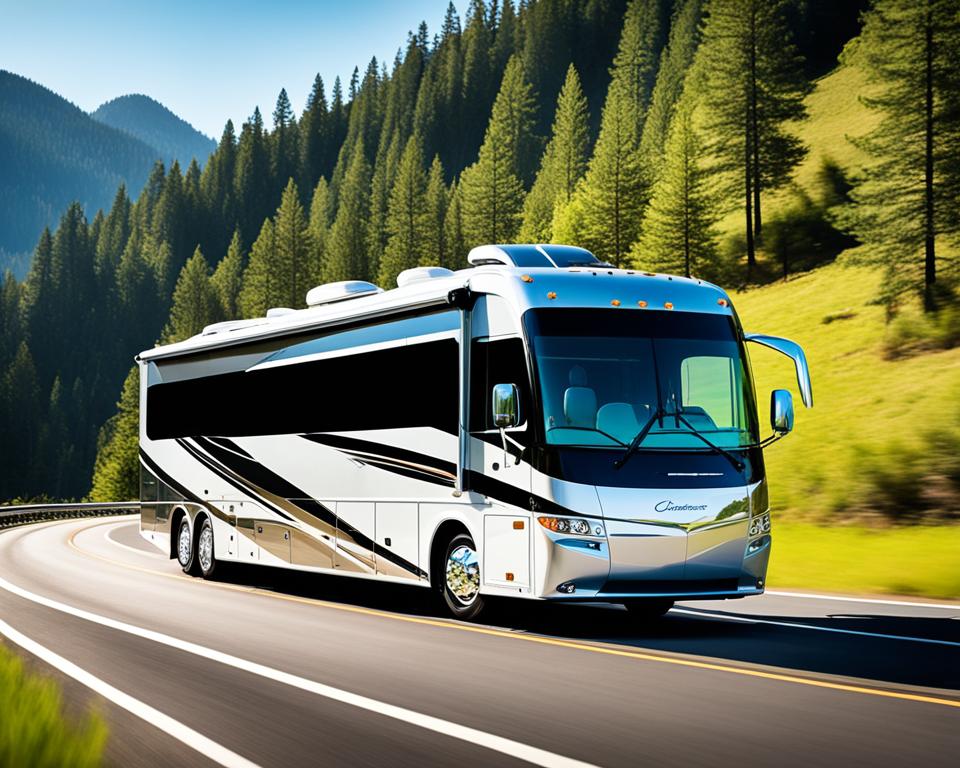RVs range in size from oversized vans to interstate buses. Beyond the sheer scale of these homes on wheels, they are extremely heavy and have limited visibility, making them challenging to drive. However, with proper preparation, practice, and some upgrades, you can improve the overall safety of your RV. Follow these tips to ensure the safest RV travel experience:
- Develop a safety checklist
- Stay buckled up while driving
- Be proactive about RV maintenance
- Replace older tires
- Add tire pressure monitors
- Balance the weight of the RV
- Secure belongings
- Practice driving an RV
- Install a backup camera
These measures can greatly enhance the safety of your RV trips.
Key Takeaways:
- Develop a safety checklist to ensure you cover all necessary precautions before setting off on your RV trip.
- Stay buckled up while driving to reduce the risk of injury in the event of an accident.
- Regularly maintain your RV according to the manufacturer’s recommended schedule to keep it in optimal condition.
- Replace older tires to minimize the risk of blowouts or accidents caused by tire failure.
- Install tire pressure monitors to receive early warnings of any tire-related issues.
RV Maintenance and Tire Safety
Proper RV maintenance is crucial for ensuring safety on the road. Many RVs travel long distances and are then parked for extended periods, leading to different maintenance requirements compared to cars. Following the manufacturer’s recommended maintenance schedule is essential.
Regularly checking the condition and inflation of the tires is particularly important for RV safety. Replace old RV tires to minimize the risk of tire blowouts and improve handling on the road. Consumer Reports recommends replacing RV tires at 10 years from the date of manufacture, or sooner if specified in the vehicle owner’s manual.
Tire pressure monitors can also be added to provide early warnings of tire problems. These devices constantly monitor the tire pressure and alert you if it falls below the recommended levels, helping you maintain optimal tire conditions and improve overall RV safety.
By staying proactive with RV maintenance and ensuring proper tire safety, you can have a worry-free and secure RV travel experience.
Regular Maintenance Checklist:
- Follow the manufacturer’s recommended maintenance schedule.
- Check tire condition and inflation regularly.
- Replace old RV tires at 10 years or sooner, as recommended.
- Add tire pressure monitors for early warnings of tire problems.
“Proper RV maintenance and tire safety are essential for a secure and enjoyable travel experience. By following maintenance schedules and replacing old tires, you can minimize the risk of accidents and improve overall road safety.” – RV Enthusiast
Weight Distribution and Loading
Proper weight distribution and loading are vital for RV safety. When it comes to loading an RV, it’s essential to consider the weight capacity and distribution. This includes taking into account factors such as the weight of towed vehicles or trailers, cargo in the storage areas, and water in the tanks. By adhering to the recommended guidelines outlined in the owner’s manual, you can ensure that your RV is loaded safely and effectively.
One key benefit of balanced weight distribution is improved handling. When the weight is evenly spread across the RV, it helps minimize sway and enhances stability, which is particularly important when navigating turns or encountering strong winds. Additionally, proper weight distribution reduces tire wear, extending their longevity and maximizing their performance on the road.
While each RV has its unique weight distribution requirements, here are some general tips to keep in mind:
- Distribute the weight evenly from front to back and side to side to maintain stability.
- Avoid placing excessive weight on the rear or extending beyond the rear of the RV, as this can affect balance and lead to handling issues.
- Consider the weight limits of storage compartments and cabinets and avoid overloading them.
- If towing a vehicle or trailer, ensure the weight is within the recommended limits and that the hitch is properly installed and secure.
By following these loading practices and prioritizing weight distribution, you can enjoy a safer and more comfortable RV travel experience.
RV Weight Distribution Tips
| Tip | Description |
|---|---|
| Distribute weight evenly | Spread the weight from front to back and side to side for better stability. |
| Avoid rear overloading | Avoid placing excessive weight at the rear, which can affect balance and handling. |
| Consider storage weight limits | Be mindful of weight limits for storage compartments and cabinets to prevent overloading. |
| Check towing limits | If towing, ensure the weight is within recommended limits and the hitch is properly installed. |
Remember, following proper weight distribution and loading practices is crucial for your RV’s stability, handling, and overall safety on the road. By taking the time to load your RV correctly and considering weight distribution guidelines, you can have a smoother and safer RV travel experience.
Securing Belongings Inside the RV
When it comes to RV travel, ensuring the safety of your belongings is just as important as securing the vehicle itself. Properly stowing and securing items inside the RV helps prevent them from moving around and causing potential hazards while the vehicle is in motion. By following these RV interior safety tips, you can maintain a safe and organized environment:
- Secure cabinets and storage compartments: Make sure all cabinets and compartments are securely closed and latched before hitting the road. This prevents items from falling out and causing accidents.
- Use storage organizers: Invest in storage organizers such as bins, dividers, and nets to keep smaller items in place and prevent them from shifting during travel.
- Secure larger items: For larger items such as appliances or furniture, use straps or bungee cords to secure them in place. This prevents them from tipping over or sliding around while on the move.
- Wrap fragile items: If you have delicate or breakable items, wrap them in padding or bubble wrap to provide extra protection and prevent damage during transit.
- Place heavier items on the bottom: When loading your RV, place heavier items on the bottom and lighter items on top. This helps maintain a lower center of gravity and reduces the risk of the RV becoming top-heavy.
By taking the time to secure your belongings inside the RV, you can create a safer travel environment and minimize the risk of accidents or injuries caused by shifting items. Remember, a well-organized interior not only promotes safety but also adds to the overall enjoyment of your RV adventures.
Expert Tip:
“Investing in storage solutions specifically designed for RVs, such as adjustable cargo bars and drawer organizers, can help maximize available space while keeping items secure.”
Safe RV Driving Practices
Operating an RV requires different skills and practices compared to driving a car or pickup truck. To ensure the safety of your RV travels, it is essential to practice driving and become familiar with its unique characteristics, such as braking distances, roof clearance, and turning radius.
Start by finding an empty parking lot where you can practice maneuvering the RV. Gradually progress to real-road situations as you gain confidence and experience. By doing so, you can become more comfortable with the size and handling of your RV.
Taking driving classes specifically tailored for RVs or seeking guidance from RV retailers can be highly beneficial. These resources can provide you with valuable insights, techniques, and tips for safe RV driving. Additionally, they can help you learn how to handle common challenges and navigate various road conditions.
Precautions for Safe RV Driving:
- Become familiar with the RV’s dimensions and blind spots.
- Always use your mirrors and check them frequently while driving.
- Maintain a safe following distance and adjust it based on the weight and length of your RV.
- Observe speed limits and drive at a speed that allows for safe control and maneuverability of your RV.
- Avoid abrupt maneuvers and apply steady pressure to the brakes and accelerator to maintain stability.
- Be cautious when turning, as the turning radius of an RV is larger compared to smaller vehicles.
Remember, practicing safe RV driving not only protects you and your passengers but also ensures the safety of other road users. By becoming a confident and skilled RV driver, you can enjoy your adventures on the road with peace of mind.
Pro Tip: “When it comes to RV driving, practice makes perfect. Take the time to familiarize yourself with the unique handling of your RV in various driving scenarios. The more you practice, the more comfortable and confident you’ll become behind the wheel.” – RV enthusiast and safe driving advocate, Michelle Johnson
| Safe RV Driving Practices | Tips |
|---|---|
| 1. Familiarize yourself with your RV’s dimensions and characteristics. | Understanding the size and handling of your RV will help you make better driving decisions. |
| 2. Practice driving in an empty parking lot. | Start in a controlled environment to become comfortable with the RV’s handling before hitting the open road. |
| 3. Take driving classes or seek guidance from RV retailers. | Professional instruction can provide valuable insights and techniques for safe RV driving. |
| 4. Use mirrors and check them frequently while driving. | Proper mirror usage helps maintain awareness of your surroundings and blind spots. |
| 5. Maintain a safe following distance. | Adjust your following distance based on the weight and dimensions of your RV. |
| 6. Observe speed limits and drive at a safe speed. | Drive at a speed that allows for proper control and maneuverability of your RV. |
Installing Backup Cameras for Improved Visibility
When it comes to RV safety, having clear visibility while reversing is essential. That’s where backup cameras come into play. By installing a backup camera in your RV, you can greatly enhance your visibility and reduce the risk of accidents caused by blind spots and obstacles.
Backup cameras provide a clear view of the area behind your vehicle, making it easier to navigate tight spaces, avoid collisions, and prevent damage to your RV. With improved visibility, you can confidently maneuver your RV in various driving situations.
If your RV doesn’t come with a backup camera installed, it is highly recommended to add one. You can choose from a variety of backup camera systems that cater to different RV sizes and preferences. Consider features like wide-angle lenses, night vision capabilities, and wireless connectivity for convenience.
In addition to backup cameras, another helpful tip for improving visibility during reversing maneuvers is to have a passenger outside the RV. This person can use a handheld radio to communicate with you and keep an eye out for blind spots or potential hazards. Their assistance can provide an extra layer of safety and help you navigate challenging situations more effectively.
Installing backup cameras in your RV can significantly enhance your visibility and improve safety while reversing. Whether you’re maneuvering in tight campground spaces or backing up in unfamiliar areas, backup cameras provide the peace of mind you need for a smoother and safer RV travel experience.
RV Rental Safety Tips
Renting an RV can be an exciting and convenient way to embark on your RV travel adventure. However, it is crucial to prioritize safety while renting and operating an RV. By following these safety tips, you can have a safe and enjoyable experience:
1. Fill out the Application and Provide a Deposit
When renting an RV, it is important to fill out the rental application accurately and provide the required deposit. This helps establish a formal agreement between you and the rental company, ensuring accountability and a smooth rental process.
2. Meet the Minimum Age Requirement
Most RV rental companies have a minimum age requirement for renters. Make sure you meet the specified age criteria before renting an RV. This requirement helps ensure that renters have sufficient driving experience and maturity to handle the vehicle responsibly.
3. Look for Rental Groups that Offer RV Training
If you are new to RV travel, consider renting from a company that offers RV training for new customers. These training programs can familiarize you with the specific features and operations of the rental RV, helping you feel more confident and prepared on the road.
4. Rent from Reputable Sources
Choose reputable RV rental sources that have a track record of providing well-maintained vehicles and excellent customer service. Reading reviews and checking ratings can help you assess the reliability and reputation of rental companies before making a reservation.
5. Ensure the RV is Well-Maintained and Equipped with Safety Features
Prior to finalizing your rental, thoroughly inspect the RV to ensure it is in good condition and has all the necessary safety features. Check the tires, brakes, lights, and other essential components. Additionally, verify that safety equipment such as fire extinguishers and smoke detectors are present and in working order.
6. Familiarize Yourself with the RV’s Operation
Before hitting the road, take the time to familiarize yourself with the operation of the rental RV. Understand how to control the vehicle’s speed, use the lights and signals, and operate any special features. This knowledge will help you navigate the road safely and confidently.
| Rental Safety Tips | Description |
|---|---|
| Fill out the Application and Provide a Deposit | Establish a formal agreement with the rental company and ensure accountability. |
| Meet the Minimum Age Requirement | Ensure you meet the specified age criteria to handle the vehicle responsibly. |
| Look for Rental Groups that Offer RV Training | Familiarize yourself with the specific features and operations of the rental RV. |
| Rent from Reputable Sources | Choose rental companies with a track record of providing well-maintained vehicles and excellent service. |
| Ensure the RV is Well-Maintained and Equipped with Safety Features | Thoroughly inspect the RV and verify the presence of essential safety equipment. |
| Familiarize Yourself with the RV’s Operation | Understand how to control the vehicle, use lights and signals, and operate special features. |
By following these RV rental safety tips, you can minimize risks and enjoy a safe and memorable journey in your rented RV.
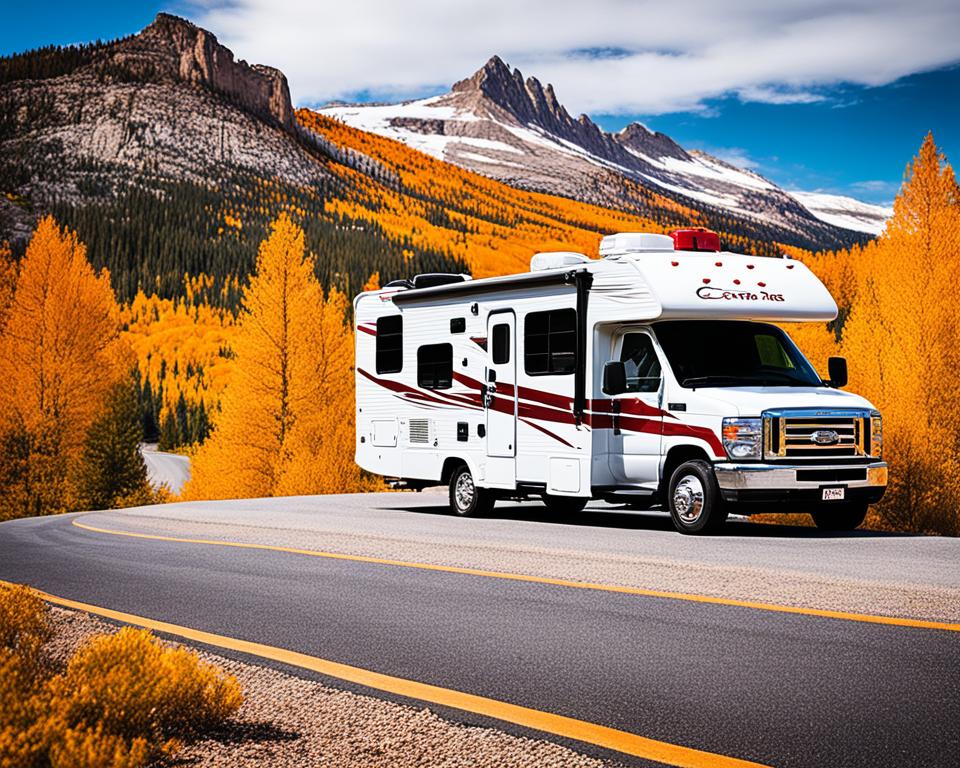
Being Aware of Surroundings and Weather
When it comes to RV safety, being aware of your surroundings is crucial. Whether you’re parked at a campground or in a remote area, always take the time to assess your surroundings before committing to staying. Look for any potential hazards or risks that could impact your RV or compromise your safety. This includes checking for uneven terrain, low-hanging branches, or other obstacles that could pose a threat.
Additionally, paying attention to the weather forecast is essential for RV safety. Weather conditions can change rapidly, and being prepared for these changes is important. Keep an eye on the forecast and be aware of any significant weather events that could affect your RV. Flooding and severe storms can be particularly hazardous for RVs. Taking proactive measures to protect your vehicle and yourself during extreme weather situations is vital.
Planning for Weather Conditions
One of the best ways to stay prepared is to plan ahead for different weather conditions. If you know you’ll be traveling in an area prone to heavy rain or storms, consider adjusting your travel plans accordingly. Stay updated with weather alerts and road conditions to avoid hazardous situations. It’s also a good idea to pack essential emergency supplies such as flashlights, extra batteries, a first aid kit, and non-perishable food items.
“Being mindful of the weather and your surroundings can significantly contribute to your RV safety and ensure a smooth and enjoyable journey.”
If you’re staying at a campground, be sure to familiarize yourself with their policies and emergency procedures. Campground staff can provide guidance in case of severe weather or other emergencies. Having a plan in place and knowing where to seek shelter can make all the difference in an unexpected situation.
Remaining Vigilant and Proactive
While enjoying the great outdoors, it’s important to stay vigilant and observant of your surroundings. Keep an eye out for any changes in the environment or signs of potential dangers. This includes being mindful of wildlife, potential falling branches, or any suspicious activities in the area. Report any concerns to campground staff or local authorities to ensure the safety of yourself and other campers.
Remember, your safety is in your hands. By being aware of your surroundings and staying informed about weather conditions, you can take proactive steps to protect yourself and your RV from potential risks.
Considering your surroundings and staying prepared for weather conditions are essential components of RV safety. By implementing these tips, you can enhance the safety of your RV trips and enjoy a worry-free travel experience.
Staying Connected and Having a Communication Plan
Staying connected and having a communication plan is essential for RV safety. When you’re on the road, especially in areas with limited cell coverage, having reliable communication devices can help you stay connected and maintain communication in case of emergencies.
Cell Signal Boosters
One option to enhance your connectivity is to use a cell signal booster. These devices amplify weak signals, allowing you to make and receive calls, send text messages, and access the internet more reliably inside your RV. With a cell signal booster, you can improve your chances of staying connected in remote areas and during challenging conditions.
Satellite Communication Devices
In addition to cell signal boosters, satellite communication devices can provide a reliable means of communication when there is no cellular coverage. These devices use satellite networks to transmit calls, messages, and even GPS coordinates. They can be a lifeline in emergency situations or when you’re exploring off-grid destinations.
Informing Family and Friends
When embarking on an RV adventure, it’s important to inform your family and friends of your travel plans. Share your itinerary, including the locations you plan to visit and the expected check-in times. This way, they can stay connected with you and be aware of your whereabouts, providing peace of mind for everyone involved.
Registering with Forest Services and Ranger Offices
If you’re planning to travel to remote areas or national parks, consider registering with forest services or ranger offices. By doing so, you can provide your location details and emergency contacts, ensuring better assistance in case of emergencies. These organizations can quickly respond to your needs and provide the necessary support.
By staying connected and having a communication plan in place, you can enhance your RV safety and enjoy a worry-free travel experience. Whether it’s through cell signal boosters, satellite communication devices, or simply keeping your loved ones informed, staying connected ensures that help is always within reach.
Self-Defense and Personal Safety
Personal safety is essential while traveling in an RV. Being aware of potential risks and having a plan for self-defense is important. Whether it’s protection from other individuals or wild animals, having a means of self-defense can provide peace of mind.
Choose a self-defense method that you feel comfortable with and practice using it. Trust your instincts and be aware of your surroundings to minimize potential risks.
Tips for RV Self-Defense:
- Carry a personal safety alarm or whistle to attract attention in emergencies.
- Consider taking self-defense classes to learn techniques for self-protection.
- Keep a charged cell phone with emergency contacts readily available.
- Invest in a high-quality flashlight for increased visibility and self-defense purposes.
- Be cautious of unfamiliar surroundings and avoid isolated areas whenever possible.
Remember, personal safety on the road is a priority. Take proactive steps to protect yourself, ensuring a safe and enjoyable RV travel experience.
Conclusion
When it comes to RV travel, safety should always be a top priority. By implementing a combination of proper maintenance, safe driving practices, and preparedness, you can ensure a worry-free and enjoyable journey in your motorhome. It all starts with following safety checklists, maintaining your tires, and balancing the weight distribution of your RV.
Securing your belongings inside the RV and practicing driving skills will further enhance your safety on the road. Installing backup cameras and being aware of your surroundings and weather conditions can greatly improve visibility and help you navigate potential hazards. Staying connected through communication devices and having a well-thought-out emergency plan are also essential for your peace of mind.
When choosing an RV, consider the safety features and ratings of different models to find the safest motorhome that suits your needs. Additionally, investing in secure RV accessories will provide an extra layer of protection for your vehicle. Remember, prioritizing safety is the key to a worry-free and enjoyable RV travel experience. Start your journey today with confidence, knowing that you have taken the necessary steps to ensure your safety on the road.
FAQ
What are some RV safety tips?
Follow these RV safety tips to ensure a safe travel experience:
How important is RV maintenance for safety?
Proper RV maintenance is crucial for ensuring safety on the road. Follow the manufacturer’s recommended maintenance schedule and regularly check the condition and inflation of the tires.
How should I load and distribute the weight in my RV?
Load and distribute the weight in your RV based on weight capacity and distribution guidelines. This helps improve handling and reduces tire wear, making your RV travel safer.
How can I secure belongings inside my RV while traveling?
Properly stow and secure all items inside your RV, including those in cabinets and storage compartments. This helps maintain a safe and organized interior environment during travel.
How can I improve my RV driving skills?
Practice driving your RV to become familiar with its unique characteristics. Start in an empty parking lot and gradually progress to real-road situations. You can also consider taking driving classes or seeking guidance from RV retailers.
Are backup cameras necessary for RVs?
Installing a backup camera in your RV can greatly enhance visibility while reversing, helping you avoid obstacles and potential hazards. It is recommended to have a backup camera or have a passenger outside to watch blind spots during reversing maneuvers.
What should I consider when renting an RV?
When renting an RV, follow safety precautions such as filling out an application, providing a deposit, and meeting the minimum age requirement. Rent from reputable sources and ensure that the RV is well-maintained and equipped with necessary safety features.
How important is being aware of surroundings and weather for RV safety?
Being aware of your surroundings, assessing the environment before staying, and staying mindful of the weather forecast are essential for RV safety. Severe weather conditions can pose risks to your RV, so it’s important to be prepared and take necessary precautions.
How can I stay connected and have a communication plan while traveling in an RV?
In areas with limited cell coverage, having a cell signal booster or a satellite communication device can help maintain communication during emergencies. Informing family and friends of your whereabouts and registering with the appropriate authorities in remote areas can also ensure better assistance in case of emergencies.
How can I ensure personal safety while traveling in an RV?
Being aware of potential risks, having a self-defense plan, and practicing personal safety measures are important while traveling in an RV. Choose a self-defense method that you feel comfortable with and always trust your instincts.
How can I choose the safest motorhome and enhance the security of my RV?
Consider the safety features and ratings of different RV models when choosing a motorhome. Additionally, investing in secure RV accessories can further enhance the security of your RV, ensuring a worry-free and enjoyable travel experience.

